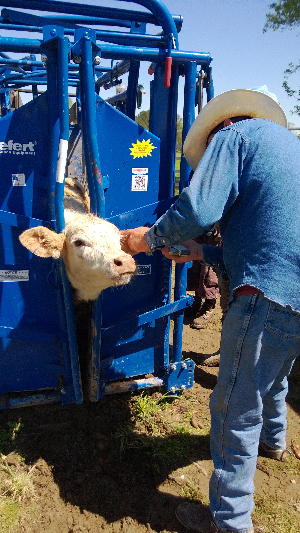Contact
Assistant Professor
Extension Veterinarian
Phone: 501-671-2162
Fax: 501-671-2185
Email: jcater@uada.edu
University of Arkansas System Division of Agriculture
Cooperative Extension Service
2301 S. University Avenue
Little Rock, AR 72204
Livestock Health
-
Livestock Health
 Herd Immunization - Monticello, AR - Cater Farm
Herd Immunization - Monticello, AR - Cater Farm
Bovine Viral Diarrhea Virus is a pathogen that is widely recognized as an important health concern for cattle producers across the United States. A vast amount of research has gone into determining the routes of transmission and possible preventive measures that are available to manage this disease.
It is estimated that BVDV costs the U.S. cattle industry over $2 billion annually, therefore, it is very important that we try to determine effective methods of disease control and prevention within our herds.
Cattle that are persistently infected with Bovine Viral Diarrhea Virus are the single most important sources of disease transmission within a herd. Persistent infection occurs when a fetus is exposed to a non-cytopathic strain of the BVD virus before day 125-150 of gestation. During these early stages of fetal development the fetal immune system is not capable of mounting an effective immune response to this virus, and from that point on, the virus is not recognized as foreign, resulting in an animal that is persistently infected with BVDV. These persistently infected animals may or may not be born with recognizable health issues. These cattle continuously shed large numbers of the virus but may appear healthy. This continuous viral shedding greatly increases the exposure and risk of infection to other cattle within the herd. Therefore, eliminating these positive animals from the herd greatly reduces the possibility of BVDV infection. Persistently infected females produce persistently infected calves which could greatly increase the number of persistently infected animals in a herd where replacement heifers are retained.
Persistently infected cattle are at a higher risk of developing other diseases and have death rates of around 50% in the first 12 months of life. They can be born undersized and have slower growth rates than their healthy herd mates. Their susceptibility to other infections often results in pneumonia and enteritis which tends to become chronic and unresponsive to treatment. Acute BVDV infection of non-persistent infected cattle results in fever, depression, weight loss, oral erosions and ulcerations, nasal discharge, diarrhea, and decreased milk production.
Acute BVDV infections also play a role in the development of Bovine Respiratory Disease due to the immunosuppressive effects of the virus. BVDV has been shown to be detrimental to early embryonic development and a cause of early embryonic death.
Transplacental infection of the fetus can occur from 50 to 100 days of gestation which may also result in fetal death. Expulsion of the fetus could occur days to months after infection. In general, late term infections resulting in abortions rarely occur. Infection of the fetus at 100-150 days of gestation may result in a number of congenital anomalies including hydrocephalus, cerebellar hypoplasia, microphthalmia, cataracts, and skeletal abnormalities.
Cattle that are persistently infected with BVDV pose a great economic threat to the industry especially at today's price levels. Therefore, it is important that we have a better understanding of the prevalence of persistently infected cattle within our state. A better understanding of the prevalence of BVDV on Arkansas farms would enable us to more effectively educate producers, county agents, and veterinarians on how to control and prevent additional BVDV infections. Gold Standard Labs reported the prevalence of persistently infected cattle from Arkansas to be 0.472%. A study of weaned calves bought from Arkansas sale barns reported a PI rate at 0.8%. Another study in 2006 reported that 16.7% of ranches in Southern Oklahoma had at least one PI calf in the 2006 calf crop.
Currently, there have not been any studies that evaluated the prevalence of persistently infected cattle in Arkansas cow/calf operations. Therefore, the objective of this study is to determine the percentage of farms in Arkansas that have at least one persistently infected BVDV case and additionally how many positive PI individuals are present at that location. Approximately fifty cow herds across the state will be selected to participate in this survey. These herds will be chosen based on their geographic location and willingness to collaborate with Extension. Ear notch samples will be collected from all calves present on the farm at the time of testing. The collected samples will be pooled together into groups of five and placed into red top tubes with 10% formalin to be sent to a diagnostic laboratory for testing. Farms containing persistently infected cattle will be identified and reported to the producers. A second round of testing will then be performed on positive submissions to identify the number of persistently infected individuals on these farms. Consultation will be available to help producers develop a strategy to eliminate BVDV from their herds.
A thorough, effective vaccination program will be discussed along with the strict biosecurity measures to prevent reintroduction of BVDV into the herd. Data collected from this study can be used to evaluate the possible need for a voluntary BVDV eradication program in Arkansas. This information will also be very valuable in our efforts to educate producers and industry personnel around the state.